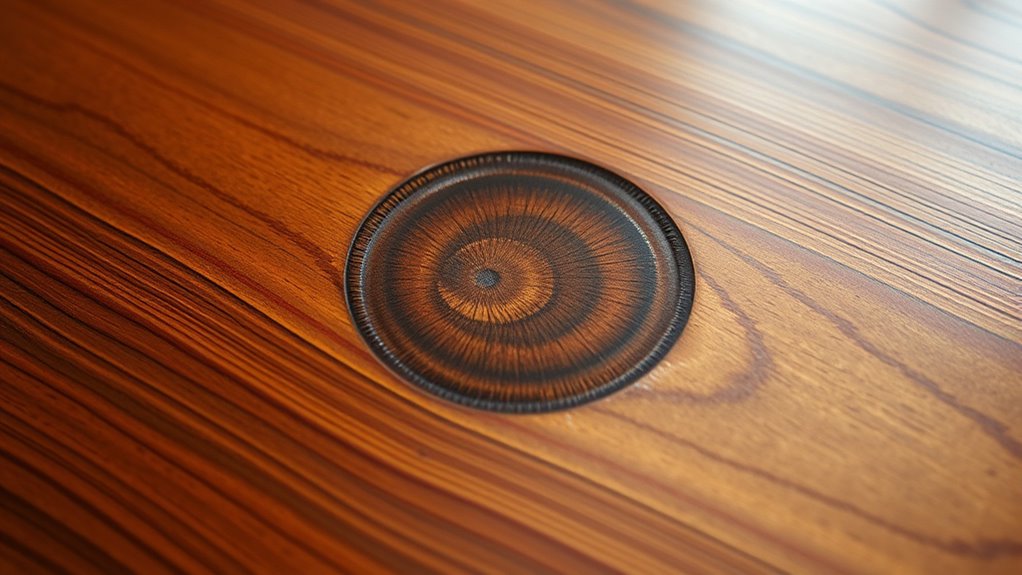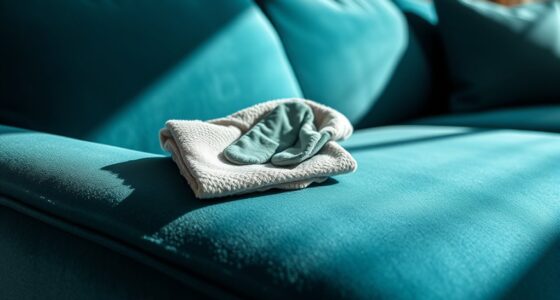To remove water rings from your wood table, start by gently cleaning the area with a soft, damp cloth and mild dish soap, then dry immediately. If the mark persists, try applying a small amount of mineral oil, furniture polish, or a baking soda paste to break down mineral deposits or moisture. For stubborn stains, placing a cloth over the spot and gently heating with a warm iron can help draw out the water. Keep your furniture protected with simple tips to prevent future damage.
Key Takeaways
- Gently wipe the water ring with a damp lint-free cloth and dry immediately.
- Apply a small amount of mineral oil or furniture polish to dissolve mineral deposits.
- Use non-gel toothpaste or a baking soda paste to gently scrub the stain.
- Place a cloth over the water ring and gently heat with a warm iron for a few seconds.
- Always use coasters and protective mats to prevent future water rings on wood surfaces.

Water rings on wood tables can be frustrating, but the good news is that you can often remove them with simple methods. These marks are usually caused by moisture seeping into the finish, creating a cloudy or white ring that tarnishes the natural beauty of your furniture. Fortunately, understanding effective cleaning techniques can help restore your table’s appearance without causing damage. It’s also wise to adopt prevention tips to avoid future water rings, saving you time and effort in the long run.
Water rings on wood tables can be removed easily with simple cleaning and prevention tips.
When tackling water rings, start with basic cleaning techniques. One of the simplest methods is to use a soft, lint-free cloth slightly dampened with a mixture of water and mild dish soap. Gently wipe the affected area, then dry it immediately with a clean cloth. If the ring persists, try applying a small amount of mineral oil or furniture polish, rubbing it in gently with a soft cloth. The oil helps dissolve the mineral deposits that cause the cloudiness, restoring clarity to the wood. For stubborn rings, place a clean cotton cloth over the stain and gently heat it with a warm iron for a few seconds. The heat and pressure can help draw out moisture trapped under the finish. Always test this method on an inconspicuous area first to prevent damage.
Another effective cleaning technique involves using household items like toothpaste or baking soda. Apply a small amount of non-gel toothpaste or a paste made from baking soda and water to the water ring. Gently rub the paste into the stain with a soft cloth, then wipe clean and dry thoroughly. These mild abrasives can help lift the stain without harming the wood finish. If you prefer a natural approach, rubbing a banana peel or mayonnaise on the water ring and leaving it for a few hours can sometimes work wonders, as the oils help penetrate and break down the moisture. After treating, always wipe away residues and dry the surface.
Prevention tips are essential to keep water rings from forming in the first place. Always use coasters under glasses, mugs, and bowls, especially if they contain liquids. Placing a cloth or placemat underneath hot or cold items adds an extra layer of protection. Regularly polishing your wood furniture with quality furniture wax or oil creates a protective barrier against moisture. Additionally, avoid placing wet or damp objects directly on the surface and wipe up spills promptly. Maintaining a consistent humidity level in your home also helps prevent wood from expanding and contracting, reducing the likelihood of water rings. Taking these simple steps can preserve your table’s beauty and minimize the need for future treatments.
Frequently Asked Questions
Can Using a Hairdryer Damage the Wood Finish?
Using a hairdryer can cause heat damage and finish deterioration if you’re not careful. The high heat can warp the wood or strip away the protective finish, leading to permanent damage. To avoid this, keep the dryer on a low setting and maintain a safe distance from the surface. Always test in an inconspicuous spot first, and consider gentler methods to remove water rings to protect your table.
Are Homemade Remedies Safer Than Commercial Products?
Think of your choice as a garden—natural remedies are like nurturing seeds, offering gentle growth, while commercial products are like fertilizers with potent chemicals. Homemade solutions often symbolize safety and harmony, making them a safer option for chemical safety concerns. You can trust natural remedies to be less harsh on your wood, but always test first. So, when it comes to removing water rings, choosing homemade options can be a wiser, safer path.
How Long Does It Take for Water Rings to Disappear?
Water rings usually take anywhere from a few hours to a couple of days to disappear, depending on the wood’s water absorption and the severity of the stain. You can speed up the drying time by gently drying the area with a soft cloth and ensuring proper ventilation. Keep in mind, patience is key, as rushing can damage the wood or worsen the water mark.
Will Polishing the Table Hide the Water Rings?
Polishing the table can temporarily improve surface appearance, but it usually won’t fully hide water rings. Polishing effectiveness depends on the severity of the marks; it may blend minor rings but won’t eliminate deep ones. If you’re aiming for a flawless look, consider using specific treatment methods first. Relying solely on polishing might give a polished surface, but the water rings could still be subtly visible beneath the shine.
Is There a Risk of Discoloration With Certain Cleaning Methods?
Yes, certain cleaning methods can pose a risk of wood discoloration. When you use harsh chemicals or abrasive tools, you might unintentionally damage the finish or stain, leading to uneven discoloration. To avoid cleaning risks, opt for gentle, wood-specific cleaning products and test them on a small, hidden area first. This way, you protect your table’s natural beauty while safely removing water rings and preventing discoloration.
Conclusion
Remember, a little care goes a long way. By promptly addressing water rings and using these simple tricks, you can restore your wood table’s natural beauty. Don’t let small stains turn into bigger problems—prevention is better than cure. As the saying goes, “A stitch in time saves nine.” Keep your furniture looking its best by acting quickly and treating it gently, and it will continue to serve you well for years to come.









